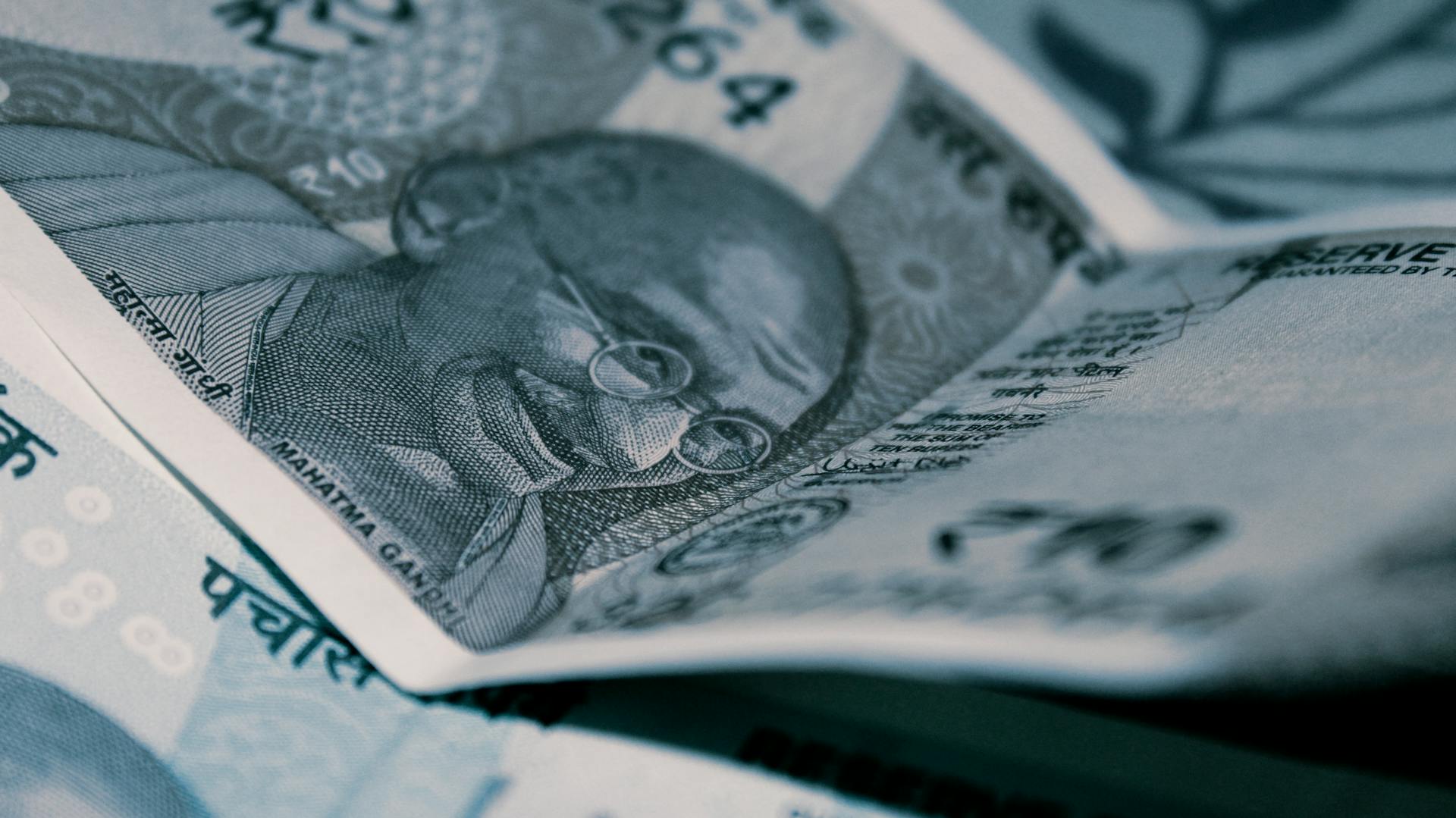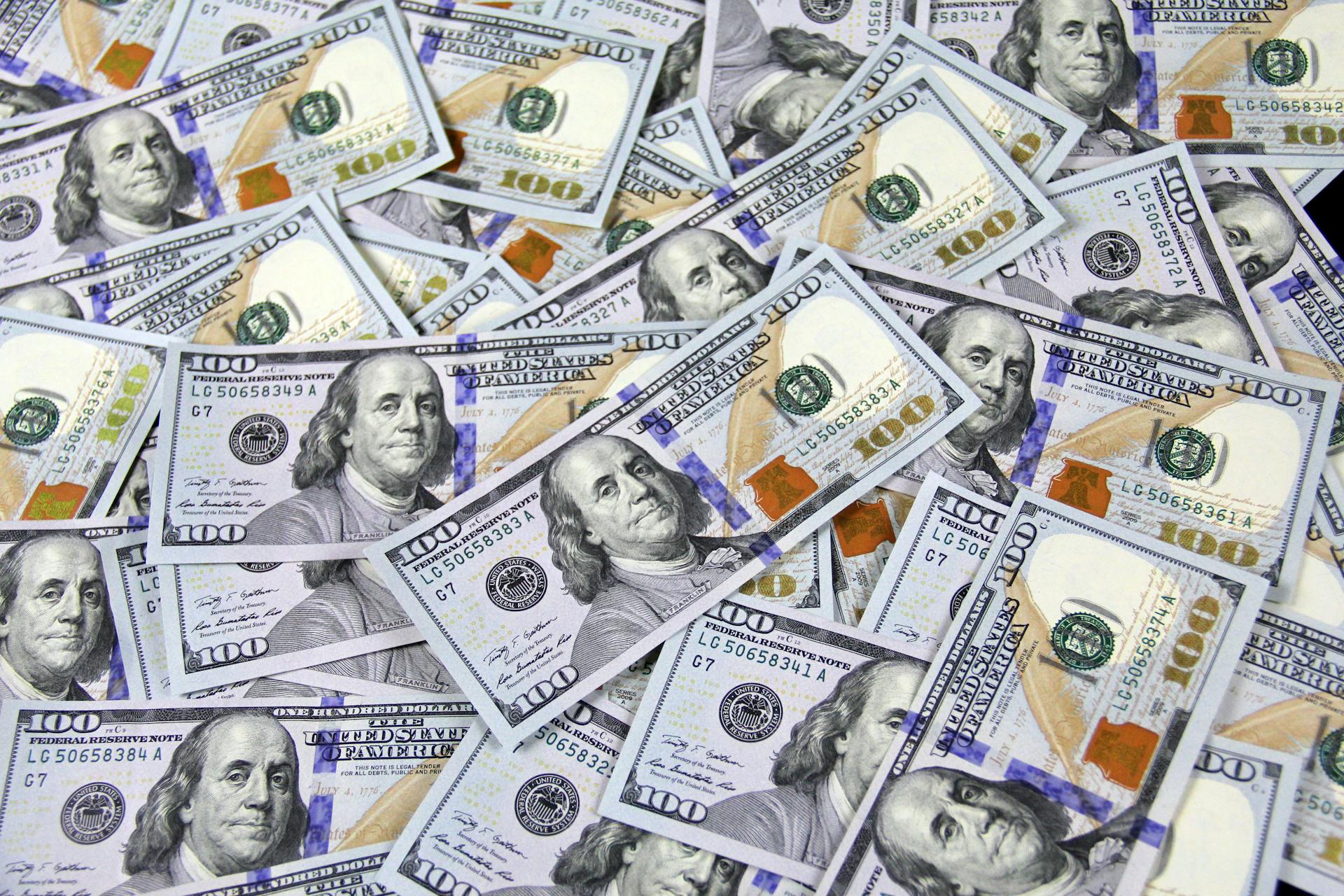
Slovakia adopted the Euro as its official currency on January 1, 2009, as part of the European Union's monetary union.
The Euro replaced the Slovak koruna, which was the country's currency since 1993.
The Eurozone is a group of 19 European countries that use the Euro as their official currency, and Slovakia was a part of it from the start.
Slovakia was one of the first countries to meet the Eurozone's convergence criteria, which includes low inflation, stable exchange rates, and sound public finances.
The Euro has been widely accepted in Slovakia since its adoption, and most businesses and services accept it as payment.
You might enjoy: Euro Currency Uk
History of Slovak Currency
The Slovak koruna, also known as the crown, was the official currency of Slovakia from 1993 to 2008.
The koruna was introduced after the peaceful split of the Czech and Slovak Federative Republic, with the Czech Republic and Slovakia forming a monetary union that was later terminated in 1993. The monetary separation was carried out by affixing banknote stamps, with a total of 86 million banknotes worth 28 billion Czechoslovak koruna put into circulation.
The coins were designed by Drahomír Zobek and minted by the Kremnica Mint, with the obverse sides featuring the state emblem of the Slovak Republic and the reverse sides documenting life on the territory of today's Slovakia in various historical periods.
The koruna was replaced by the euro in 2009, but the coins were exchangeable for euros at the National Bank of Slovakia until January 2, 2014.
Prehistory – Money Before Coins
In the earliest period of human society, trade took simple and somewhat haphazard forms, with a wide range of natural products being exchanged, including stones, shells, and tools made from them.
Precious metals, especially gold and silver, eventually became dominant as a general equivalent, a measure of value, against which the value of other items could be compared.
The situation in Slovakia changed greatly as the Roman Empire pushed its borders to the banks of the River Danube, establishing a line of fortified camps and trading posts.

A rare find in Slovakia is an antonianus overstruck on an earlier silver denarius, which shows Regalianus – a usurper of the Roman Empire who was acclaimed and then murdered by his own troop in just a few days around 260 CE.
The Byzantine gold solidus became the generally accepted currency of international trade, and its name comes from the Latin word “solidus”, which means “massive, solid, enduring”.
The Byzantine gold solidus preserved its high weight and purity of metal until the fall of the Byzantine Empire, a testament to the durability of this ancient currency.
You might enjoy: Does Canada Have Their Own Currency
History
The Slovak koruna, or crown, has a rich history that spans over 70 years. It was first introduced in Czechoslovakia in 1939.
The crown was used as the official currency in Slovakia until 2008, when it was replaced by the euro. However, the koruna has a fascinating history that predates its official introduction in 1993.
A fresh viewpoint: Czech Koruna Czk
The monetary separation between the Czech and Slovak Republics took place on February 8, 1993, and was carried out by affixing banknote stamps. A total of 86 million banknotes worth 28 billion Czechoslovak koruna were put into circulation.
The first Slovak coin to be put into circulation was the 10-crown coin, which was minted by the Kremnica Mint. The obverse side of the coin features the state emblem of the Slovak Republic, while the reverse side depicts a theme documenting life on the territory of today's Slovak Republic in various historical periods.
The Slovak koruna was used in various denominations, including coins of 1, 2, and 5 crowns, as well as banknotes in denominations of 20 to 5000 monetary units. The coins were made from an alloy of aluminium and magnesium, while the banknotes were printed by the Canadian Banknote Company, Ltd.
Here's a brief overview of the Slovak koruna denominations:
The Slovak koruna was a significant part of the country's history, and its legacy continues to be felt today.
Slovak Koruna
The Slovak Koruna has a fascinating history. It was introduced in 1993, replacing the Czechoslovak koruna at par.
In 1993, the newly independent Slovakia introduced its own koruna, replacing the Czechoslovak koruna at par. This marked a significant change for the country's currency system.
The Slovak koruna has been the official currency of Slovakia ever since.
Euro Adoption
Slovakia has been a member of the European Union since 2004 and has been using the Euro as its official currency since 2009, but it's not without its challenges.
The Euro adoption in Slovakia was a gradual process that began in 2009, with the country introducing the Euro as its official currency on January 1st of that year.
However, it's worth noting that the Euro was not widely accepted in Slovakia until 2013, when the country's economy had stabilized and the government had implemented various measures to promote its use.
Worth a look: Does France Use the Euro for Currency
Adopting the Euro
The European Union's decision to adopt the Euro as a single currency was made in 1992 by the Maastricht Treaty.
The Euro was introduced in 1999 as an accounting currency, with cash euros not available until 2002.
The adoption of the Euro required member states to meet certain economic criteria, including low inflation and stable interest rates.
The Eurozone currently consists of 19 of the 27 EU member states.
The Euro has been a stable currency, with its value fluctuating by only 5% in the past decade.
Check this out: What Was the Currency in Germany before Euro
Slovak Euro Design
The Slovak euro design is a beautiful representation of the country's rich history and culture. It features Kriváň, a symbolic mountain in the High Tatras, on the €0.01, €0.02, and €0.05 coins.
Each design has a unique touch, with Kriváň being a striking feature on these coins. The designers, Drahomír Zobek, Ján Černaj, and Pavol Károly, have done an excellent job in bringing the Slovak spirit to life.
The €0.10, €0.20, and €0.50 coins showcase Bratislava Castle, a stunning architectural wonder in Slovakia. This iconic landmark is a testament to the country's rich history and cultural heritage.
The designs on the Slovak euro coins are truly a reflection of the country's identity. The Coat of arms of Slovakia, the Double Cross on Three Hills, is featured on the €1.00 and €2.00 coins.
Here's a summary of the Slovak euro coin designs:
Currency and Exchange
The Slovak koruna was introduced in 1993, replacing the Czechoslovak koruna at par, and was used until 2009 when Slovakia adopted the euro.
Slovak banknotes denominated in koruny can be exchanged for euros indefinitely.
The exchange rate for the Slovak koruna to the euro was 1 EUR = 30.1260 SKK when Slovakia entered the Eurozone in 2009.
Banknotes
The Slovak koruna was introduced in 1993, replacing the Czechoslovak koruna at par. It was used in Slovakia until 2009.
Slovak banknotes were issued in denominations of 20, 50, 100, 500, and 1,000 korún, and later, in 1994 and 1995, 5,000 korún and 200 korún banknotes were introduced. The 200 korún note was introduced in 1995.
The Slovak koruna can be exchanged for euros indefinitely. The exchange rate was 1 EUR = 30.1260 SKK.
Here's a list of Slovak banknotes, including their dimensions, value in euros, and main colors:
Coins
The Slovak crown is divided into 100 hellers, with the official abbreviation being "hal". There were seven coins of the nominal value, including the 10 Sk coin.
The Slovak koruna commemorative coins are a special type of coin, but let's focus on the regular coins. In 1993, coins were introduced in denominations of 10, 20 and 50 haliers, 1, 2, 5 and 10 korunas.
The 10 and 20 halier coins were taken out of circulation on December 31, 2003. In 1996, the 50 halier coin was made smaller and instead of aluminium, it was made with copper plated steel.
Here's a list of the coins, including their values and designs:
- 10 halierov (silver-coloured) - Octagonal wooden belfry from Zemplín (early 19th century) = €0.0033
- 20 halierov (silver-coloured) - the Kriváň peak in the High Tatras = €0.0066
- 50 halierov (copper-coloured) - Renaissance polygonal tower of Devín Castle = €0.0166
- 1 koruna (copper-coloured) - Gothic wooden sculpture of the Madonna with child (c. 1500) = €0.0332
- 2 koruny (silver-coloured) - Earthen sculpture of the sitting Venus of Hradok (4th millennium BC) = €0.0664
- 5 korún (silver-coloured) - Reverse of a Celtic coin of Biatec (1st century BC) = €0.166
- 10 korún (copper-coloured) - Bronze cross (11th century A.D.) = €0.332
Coins were exchangeable for euros at the National Bank of Slovakia until January 2, 2014.
Historical Exchange Rates
The euro and Slovak koruna have had a fascinating exchange rate history. The koruna joined the ERM II on November 28, 2005, at the rate of € = 38.4550 Sk with a 15% band.
This rate was readjusted on March 17, 2007, to 35.4424 Sk, an 8.5% increase in the value of the koruna. On the same day, 1 euro traded at 33.959 Sk. This change reflects the strengthening of the Slovak economy.
The central rate of koruna was adjusted once more on May 28, 2008, to 33.8545 with no change in the band.
Comparison and Establishment
Slovakia has two official currencies: the Euro and the Slovak koruna. The Euro is the primary currency used in Slovakia.
The Slovak koruna was the country's official currency from 1993 to 2009. It's no longer in circulation.
The Euro was introduced in Slovakia in 2009, replacing the koruna. This changeover was a significant event in the country's economic history.
As of 2009, the Slovak koruna was pegged to the Euro at a fixed exchange rate. This allowed for a smooth transition to the Euro.
Slovakia's adoption of the Euro has brought many economic benefits, including increased trade and investment with other Eurozone countries.
Frequently Asked Questions
Can you use US dollars in Slovakia?
No, US dollars are not widely accepted in Slovakia, making it best to exchange for Euros before your trip or use a credit card with no foreign transaction fees.
Sources
Featured Images: pexels.com


